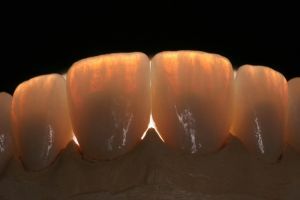 With the help of crowns, it is possible to restore significant damage to the teeth, returning an aesthetic appearance to the necessary part of the tooth row, and even in some cases, improving it.
With the help of crowns, it is possible to restore significant damage to the teeth, returning an aesthetic appearance to the necessary part of the tooth row, and even in some cases, improving it.
The ability of the jaw to bite off food is also restored. A properly executed design will be visually indistinguishable from natural teeth.
In dentistry, several types of material for the production of crowns are used, and in order to stop selection on one of them, all existing variants should be analyzed.
Contents
- Features of the restoration of the front teeth
- Metal crowns - the unforgettable classic
- Metal ceramic - medium budget option
- Whole-ceramic crowns are the best choice
- Products from oxide and zirconium dioxide
- Temporary plastic crowns
- Sick matter -
- price Source of truth - practical experience
- Conclusions andtheses
- Alternative to the crowns
Features of the restoration of the front teeth
Restoration of the broken cutters can be applied with savedand their root part. If the tooth is spoiled completely - it is necessary to attach the prosthesis to a pre-installed implant.
If there is a chipped tooth with a normal root, the restoration will be carried out by one of the following methods:
- , a pin is fixed to the pre-sealed root canals and a crown is placed on top;
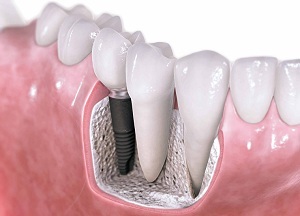
- crown attached to the cult insert;
- prosthesis is installed on a pre-implanted implant.
The difference between the front row of teeth and the side teeth is that they can not be saved without aesthetic disability. After all, the front teeth first of all fall into the field of view of the interlocutor, bare with a smile and conversation.
Therefore, to ensure maximum aesthetics, you should carefully select crowns on the front teeth.
Usually, for the restoration of the teeth of the front row, ceramic or metal-ceramic crowns are used, which have high aesthetic characteristics.
Consider the main options available.
Metal crowns - unforgettable classics
Such crowns have great strength and are used for a long time. In the absence of alternative options, they were previously installed on any teeth, despite the fact that they differ in color from them.
Pros of metal prostheses:
- they are very durable, durable and inexpensive;
- teeth do not need to be sharpened before the crowns are inserted;
- , such products are manufactured in the oven by the wax cast and do not practically need to be adjusted;
- with the installation of gold-plated crowns, they will last for several decades, with a therapeutic effect on the oral cavity.
Cons of crowns made of metal: 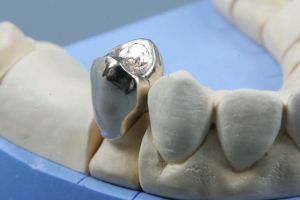
- metallic taste in the mouth, possibly also burning;
- is not aesthetic;
- possible allergic reactions to the metal.
Nowadays such crowns are used only for lateral teeth, which are not visible during conversation and with a smile.
Metal Ceramics - Medium Budget Variant
The most used materials used for the fabrication of products are a chromium alloy with nickel or cobalt.
They rarely cause allergic reactions, are inexpensive and have good bio-compatibility. Alloys of gold and platinum will last even longer, accordingly, such a crown is not cheap.
They are produced by combining a metal frame and a ceramic coating. As a result, the products have high strength, aesthetic appeal and natural appearance.
Pros of ceramic-metal crowns:
- due to the strong metal frame products can withstand large masticatory loads without damage;
- period of use of cermets, if you adhere to the rules of hygiene, reaches 10 years or more;
- have an aesthetic appearance and are visually almost indistinguishable from natural teeth;
- with all the advantages of a product made of such material have a relatively low cost.
Cons of this solution:
- Before installing the cermets, the incisors are subjected to significant grinding( up to 2 mm on both sides).
- In most cases, the tooth is depulled, because when grinding the pulp often kills, which often reveals the
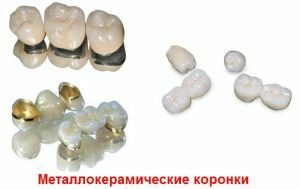 when the crowns are installed. As a result, you have to remove the crown to treat the inflamed incisor, and then reinstall it.
when the crowns are installed. As a result, you have to remove the crown to treat the inflamed incisor, and then reinstall it. - Immediately after installation or after some time after the edge of the crowns, blue may form. It is especially noticeable with a big smile. This defect is associated with the metal base of the product.
- When prosthetics of one or two teeth, the difference between the actual incisors and the crown can be seen. When you install several teeth, the difference is not so obvious. This is due to the ability of the human eye to constantly compare symmetrical objects.
- In the light, you can see the opacity of products compared to natural teeth.
Whole-ceramic crowns - the best choice
Ceramic crowns are specially designed for installation on the front teeth. They have a very natural appearance and are virtually visually distinct from natural incisors.
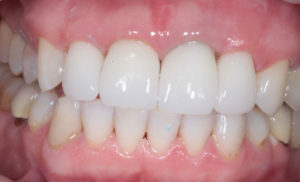
This is how the crowns made of ceramics are placed on the front teeth of the
. At the same time, the ceramic crown is brittle because, unlike cermets, it does not have a metal frame. They are not used for chewing and removed teeth.
But to ensure a high naturalness and aesthetics, these products are ideal. The restoration of the porcelain crown is almost impossible.
Ceramic advantages:
- Durability and reliability .Even after dozens of years, the environment of the mouth is not able to change the color of the crowns.
- High level of aesthetics .Ceramic products are indistinguishable from real incisors in color and transparency, even in bright natural light. This makes them an excellent material for restoring the front teeth.
- Biocompatibility .Restoring the teeth with these crowns will not affect the condition of the gums and oral cavity, thanks to the biocompatibility of the material.
Disadvantages of ceramic products:
- Porcelain material is used only for single crowns , bridges can be made solely from expensive zirconium.
- Higher cost of compared to cermet.
- Under these prostheses, it is possible to use only ceramic inserts and fiberglass pins, it is not possible to use metal as it will be visible through a transparent crown and give it a blue tint.
Products from oxide and zirconium dioxide
This is the most expensive material for the manufacture of prostheses. They are very aesthetic and natural in appearance, have a high 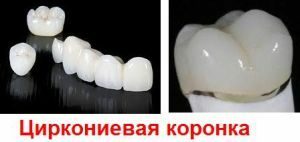 biocompatibility with the tissues of the oral cavity.
biocompatibility with the tissues of the oral cavity.
The crown frame is made by the way of milling with the help of a computer, which allows to obtain durable and high-quality coating.
Pros of zirconium crowns:
- you can pick up a crown, indistinguishable in color from real teeth;
- such material is ideal for the manufacture of anterior bridge prostheses;
- such crowns have higher strength compared to porcelain;
- do not give defects in the form of blue on the edge of the gum;
- material has hypoallergenic properties.
The main disadvantage is the high cost of installing such a crown.
Temporary plastic crowns
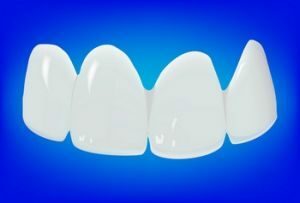 These crowns are set for the time required to manufacture permanent prostheses. They allow you to protect your turned teeth from the impact of the environment, keep the right speech and confidence in communication.
These crowns are set for the time required to manufacture permanent prostheses. They allow you to protect your turned teeth from the impact of the environment, keep the right speech and confidence in communication.
These prostheses are set for a period of 2 to 4 weeks. Plastic crowns, reinforced with a metal base, can last about 5 years. It is possible to restore such crowns without removing them if the plastic sheath collapses.
The sick question is the price of
The prices for products are directly proportional to the cost of the material:
- The cost of the most inexpensive bit made of plastic ranges from 300 to 600 rubles. The stationary plastic construction will cost 1000 rubles.
- The cost of prosthesis made from cermet will be in the range of 6000-13000 rubles, and the same product on a gold frame will cost 24000 rubles + 3000 for each gram of the alloy.
- Porcelain crown can cost in the amount of 13,000 to 22,000 rubles.
- A qualitative prosthesis made of zirconium oxide - in 24000-27000 rubles.
In the cost of treatment, in addition to the price of materials, the specialists' salaries, equipment costs, diagnostics, sterilization and other components are also included.
The source of truth - the practical experience of
Definitely determine the crown of which material is better to install on the front teeth, will help reviews patients.
Six years ago I put cermets on the front tooth. Despite the fact that she was alone, the difference in color in the eyes did not rush. However, after a while everything changed. Now the crown looks much lighter than my native teeth, probably because of their yellowing. I hope to correct the situation with the help of bleaching.
Galina Ivanovna, Rostov
I had fine teeth before 30 years, did not know the way to dentistry. But after the received trauma it was necessary to take advantage of services of the dentist.
I installed a ceramic crown on the front tooth. At first I tried not to smile, I thought that there would be a big difference. But, to my surprise, none of my friends even noticed that I have a prosthesis.
Yuri, Krasnodar
I put the crowns of cermets on the upper front teeth. The installation process was lengthy, with selection and temporary crowns, much more than expected. After the first selection of color and setting, it was necessary to remove and re-install, because one tooth protruded, and there was a noticeable color difference between the lower and upper teeth. But, in the end, I'm happy with the result, despite all the vicissitudes.
Tatyana, Ekaterinburg
Conclusions and theses
What are the crowns better to install on the front teeth: porcelain, zirconium, plastic or cermets? 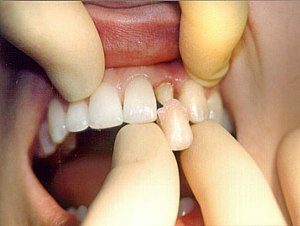
In all respects, the best are crowns made of zirconium, but they are also the most expensive ones. Plastic and metal-ceramic crowns are the most affordable, but the first are short-lived, and the second ones can cause allergies in some.
Porcelain crowns will be an excellent choice if one tooth is needed in prosthetics, but if there are several, the option does not fit.
Obviously, the choice should be made based on material possibilities, and then other criteria.
Alternative to Crowns
An alternative is to restore a pair of damaged front teeth with implantation or a removable prosthesis.
When restoring the dentition with veneers, the inner wall of the incisor should be retained or have a slight defect. If, for example, the front surface of the tooth and the edge are destroyed, then restoration with veneer is possible.
Restoration of the destroyed wall of the incisor with a filling material is performed if the tooth crown is damaged less than half. With a greater amount of damage, the installation of the prosthesis is indicated.
If you restore such a tooth with the help of sealing, it will most likely break down during chewing and it will have to be removed.
